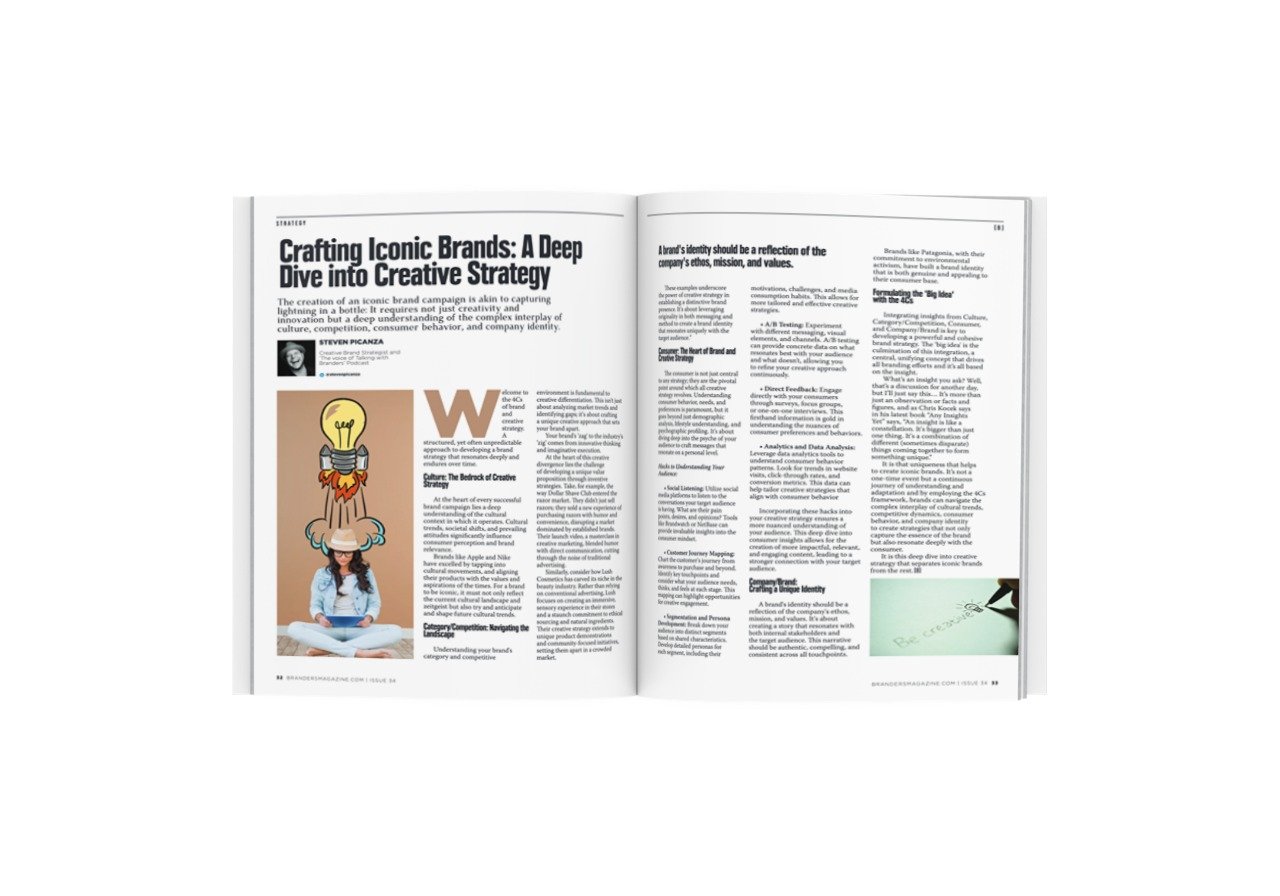Crafting an Iconic Brand
Don't settle for ordinary when extraordinary is within reachCiao Amici,
The creation of an iconic brand campaign is akin to capturing lightning in a bottle: It requires not just creativity and innovation but a deep understanding of the complex interplay of culture, competition, consumer behavior, and company identity.
Welcome to the 4Cs of brand and creative strategy. A structured, yet often unpredictable approach to developing a brand strategy that resonates deeply and endures over time.
The following post was taken from my most recently published article in Branders Magazine.
Culture: The Bedrock of Creative Strategy
At the heart of every successful brand campaign lies a deep understanding of the cultural context in which it operates. Cultural trends, societal shifts, and prevailing attitudes significantly influence consumer perception and brand relevance.
Brands like Apple and Nike have excelled by tapping into cultural movements, aligning their products with the values and aspirations of the times. For a brand to be iconic, it must not only reflect the current cultural landscape and zeitgeist, but also try and anticipate and shape future cultural trends.
Category/Competition: Navigating the Landscape
Understanding your brand's category and competitive environment is fundamental to creative differentiation. This isn't just about analyzing market trends and identifying gaps; it's about crafting a unique creative approach that sets your brand apart.
Your brand's 'zag' to the industry's 'zig' comes from innovative thinking and imaginative execution.
At the heart of this creative divergence lies the challenge of developing a unique value proposition through inventive strategies. Take, for example, the way Dollar Shave Club entered the razor market. They didn't just sell razors; they sold a new experience of purchasing razors with humor and convenience, disrupting a market dominated by established brands. Their launch video, a masterclass in creative marketing, blended humor with direct communication, cutting through the noise of traditional advertising.
Similarly, consider how Lush Cosmetics has carved its niche in the beauty industry. Rather than relying on conventional advertising, Lush focuses on creating an immersive, sensory experience in their stores and a staunch commitment to ethical sourcing and natural ingredients. Their creative strategy extends to unique product demonstrations and community-focused initiatives, setting them apart in a crowded market.
These examples underscore the power of creative strategy in establishing a distinctive brand presence. It's about leveraging originality in both messaging and method to create a brand identity that resonates uniquely with the target audience."
Consumer: The Heart of Brand and Creative Strategy
The consumer is not just central to any strategy; they are the pivotal point around which all creative strategy revolves. Understanding consumer behavior, needs, and preferences is paramount, but it goes beyond just demographic analysis, lifestyle understanding, and psychographic profiling. It's about diving deep into the psyche of your audience to craft messages that resonate on a personal level.
Hacks to Understanding Your Audience:
Social Listening: Utilize social media platforms to listen to the conversations your target audience is having. What are their pain points, desires, and opinions? Tools like Brandwatch or NetBase can provide invaluable insights into the consumer mindset.
Customer Journey Mapping: Chart the customer's journey from awareness to purchase and beyond. Identify key touchpoints and consider what your audience needs, thinks, and feels at each stage. This mapping can highlight opportunities for creative engagement.
Segmentation and Persona Development: Break down your audience into distinct segments based on shared characteristics. Develop detailed personas for each segment, including their motivations, challenges, and media consumption habits. This allows for more tailored and effective creative strategies.
A/B Testing: Experiment with different messaging, visual elements, and channels. A/B testing can provide concrete data on what resonates best with your audience and what doesn't, allowing you to refine your creative approach continuously.
Direct Feedback: Engage directly with your consumers through surveys, focus groups, or one-on-one interviews. This firsthand information is gold in understanding the nuances of consumer preferences and behaviors.
Analytics and Data Analysis: Leverage data analytics tools to understand consumer behavior patterns. Look for trends in website visits, click-through rates, and conversion metrics. This data can help tailor creative strategies that align with consumer behavior
Incorporating these hacks into your creative strategy ensures a more nuanced understanding of your audience. This deep dive into consumer insights allows for the creation of more impactful, relevant, and engaging content, leading to a stronger connection with your target audience.
Company/Brand: Crafting a Unique Identity
A brand's identity should be a reflection of the company's ethos, mission, and values. It's about creating a story that resonates with both internal stakeholders and the target audience. This narrative should be authentic, compelling, and consistent across all touchpoints.
Brands like Patagonia, with their commitment to environmental activism, have built a brand identity that is both genuine and appealing to their consumer base.
Formulating the 'Big Idea' with the 4Cs
Integrating insights from Culture, Category/Competition, Consumer, and Company/Brand is key to developing a powerful and cohesive brand strategy. The 'big idea' is the culmination of this integration, a central, unifying concept that drives all branding efforts and it’s all based on the insight.
What’s an insight you ask? Well, that’s a discussion for another day, but I’ll just say this… It’s more than just an observation or facts and figures, and as Chris Kocek says in his latest book “Any Insights Yet” says, “An insight is like a constellation. It's bigger than just one thing. It's a combination of different (sometimes disparate) things coming together to form something unique.”
It is that uniqueness that helps to create iconic brands. It’s not a one-time event but a continuous journey of understanding and adaptation and by employing the 4Cs framework, brands can navigate the complex interplay of cultural trends, competitive dynamics, consumer behavior, and company identity to create strategies that not only capture the essence of the brand but also resonate deeply with the consumer.
It is this deep dive into creative strategy that separates iconic brands from the rest.
To your unstoppable success,
-Steven ✌️🍕
P.S. I’m starting to regularly publish video content on my YouTube channel. Are you a subscriber yet? 👇👇👇
P.P.S. Whenever you're ready, there are 3 ways I can help you:
#1: Ready to grow your corporate or personal brand? Let's chat. >>> Click here to book a call with me
#2: Have you seen my YouTube Channel? I'm putting a ton of energy into creating heaps of valuable content that I think you'll like. Come check out my latest stuff, and give me a like and subscribe.
#3: Follow me on LinkedIn for more branding tips, marketing hacks, and community-building systems.


